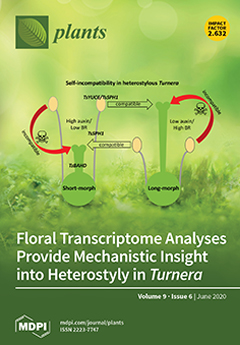Class II high-affinity potassium transporters (HKT2s) mediate Na
+–K
+ cotransport and Na
+/K
+ homeostasis under K
+-starved or saline conditions. Their functions have been studied in yeast and
X. laevis oocytes; however, little is known about their respective
[...] Read more.
Class II high-affinity potassium transporters (HKT2s) mediate Na
+–K
+ cotransport and Na
+/K
+ homeostasis under K
+-starved or saline conditions. Their functions have been studied in yeast and
X. laevis oocytes; however, little is known about their respective properties in plant cells. In this study, we characterized the Na
+ and K
+ transport properties of SvHKT2;1, SvHKT2;2 and HvHKT2;1 in Arabidopsis under different ionic conditions. The differences were detected in shoot K
+ accumulation and root K
+ uptake under salt stress conditions, K
+ accumulation in roots and phloem sap under K
+-starved conditions, and shoot and root Na
+ accumulation under K
+-starved conditions among the
HKT2s transgenic lines and WT plants. These results indicate the diverse ionic transport properties of these HKT2s in plant cells, which could not be detected using yeast or
X. laevis oocytes. Furthermore, Arabidopsis expressing
HKT2s showed reduced salt tolerance, while over-expression of
HvHKT2;1 in barley, which has the ability to sequestrate Na
+, showed enhanced salt tolerance by accumulating Na
+ in the shoots. These results suggest that the coordinated enhancement of Na
+ accumulation and sequestration mechanisms in shoots could be a promising strategy to confer salt tolerance to glycophytes.
Full article






